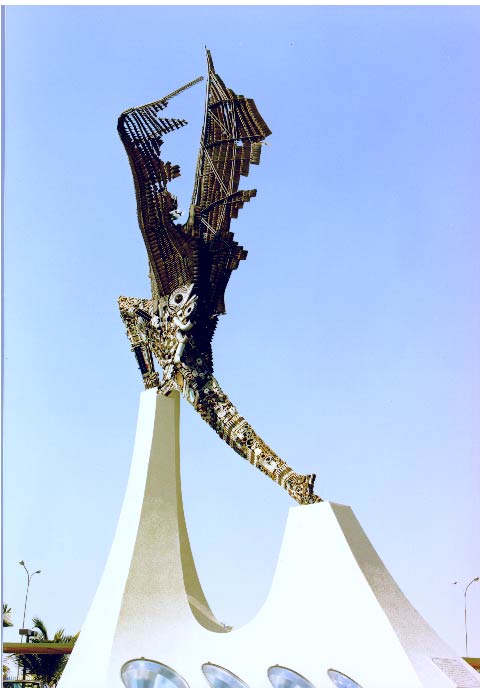“Stop, friends! Let us stay and weep at the thought of my love, She lived here on the desert’s edge between Al Dakhooli and Howmali, Tudiha and Mirkat! the campsite has not been erased even as the south and north winds cross weave across the sands…” —The 6th Century Prince Poet Imru’ Al-Qays
A place, a song, a certain fragrance, a particular dish, a specific date: All of these can trigger memories and a sense of nostalgia and longing for something that once was.
For some, a patch of land in the middle of the desert can lead to tears, as they have for past poets and travelers across its harsh terrain.
And for the past 35 years, a particular Saudi landmark has been imprinting itself on the memories of millions of travelers, who upon seeing it again, are overwhelmed with feelings of longing.
“The Makkah Gate is one of my proudest creations,” said Saudi artist Dia Aziz Dia, the structure’s designer in an exclusive interview with Ithraeyat.
A sketch of the famous Makkah Gate by Saudi artist Dia Aziz Dia, dated 14/8/1979.“

“It has become the gateway to the hearts of all Muslims. I am honored to have been part of creating a collective sense of nostalgia and a memory of a journey for all those who have passed through.” A magnificent structure that spans the width of the Jeddah-Makkah highway, in the shape of a Holy Qur’an resting on a wooden stand — it is indeed the gateway to the heart of Islam, about five kilometers from Makkah. Also known as the ‘Qur’an Gate,’ Makkah Gate was designed by Mr. Dia in 1979 and was built across 7,296 square meters, at a length of 152 meters and 48 meters in width.
“An artwork in whatever form it may be, can fascinate you, can make you think, ponder and recall. It stimulates your imagination, influences your soul. Once you see it, you never forget it,” said Mr. Dia, who was one of the first Saudi artists to attend the Accademia di Belle Arti di Roma (academy of fine arts) in Rome. Artistic landmarks across Saudi Arabia in public places, whether at roundabouts, malls, beaches or even in a neighborhood often trigger the strongest sentiment when reflected upon. One such place famed for its public art is Jeddah, estimated to have over 600 pieces across the city. Designed by Saudi and international artists, there are pieces that are unforgettable, such as The Four Lanterns (Mamluk Mosque Lamps), the Fist and the iconic Bicycle which was recently removed and made headline news for being uprooted after standing 15 meters tall in one place since 1982. Picnics and photos were taken at these public artworks, delighting residents and visitors with their creativity and vision.
“Saudi Arabia is building its art scene through growing support,” said Mr. Dia, naming Ithra as one of those iconic “cultural sculptures” before becoming a fully functional building. Born in Cairo in 1947, the award-winning sculptor is also a painter, a sketcher, a photographer and a multi-disciplinary artist with over 40 years of contribution to the Saudi art scene. He “continues to try his hand with new creations” and said he doesn’t limit himself as there “is no limit in art.” “Art is the translation and transmission of emotional feelings from the depths of the soul to the perceived visible world,” said Mr. Dia, who admits he is sensitive and sentimental by nature.

Perhaps many people do not know that I tear up easily, whether at a particular sad piece of music, or a sad scene in a movie or a kind word from a person I don’t know, and even at the innocent joy of a child when getting a new toy.” While he has traveled across the world, it is art inspired from Saudi life, past and present, that dominates Mr. Dia’s art.“
“ When asked to share a memory, Mr. Dia mentioned a favorite childhood pet, a German Shepherd called ‘Lucky’ who watched over him as a child in India, and another beloved dog pet in Jeddah called Haris (Guard). Whether it is an old photo album, reading over a tattered old letter, watching old films or TV shows once watched with the family, or even visiting those Baleela (chickpeas) trolleys parked along the beach front, the art of nostalgia is not limited to one form or another, it can be anything that one once held dear, even a collection of sand dunes.
Written by Rym Tina Ghazal












